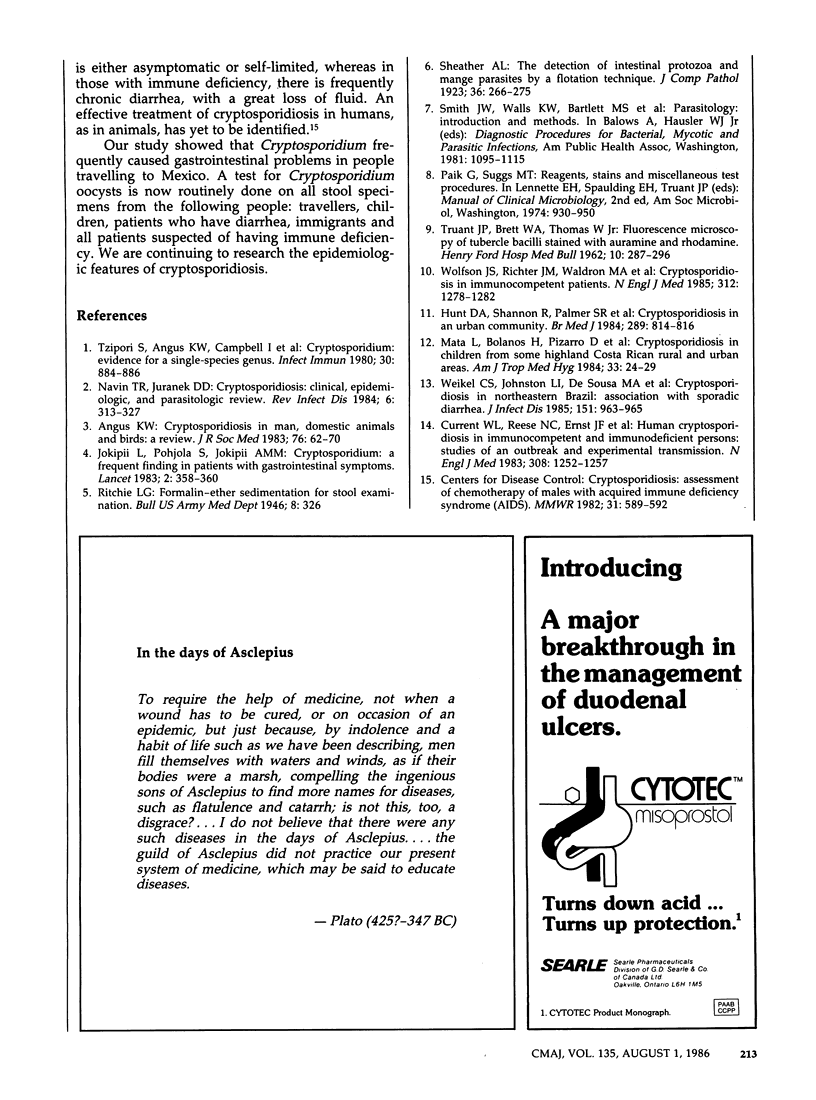Abstract
Between Oct. 1, 1983, and June 30, 1985, Cryptosporidium oocysts were identified in stool specimens from 74 patients who presented with gastrointestinal symptoms to their physicians. Questionnaires prepared to determine travel history, symptoms, duration of illness and epidemiologic characteristics of the infection were completed for 67 (90%) of the patients by their physicians; the information on the other 7 patients was obtained from the requisitions accompanying the specimens. Of the 67, 35 (52%) had recently been to Mexico. The infection was likely transmitted through contaminated water, food and, possibly, milk. The infections in patients who had not travelled were thought to be due to contact with infected pets or farm animals or with infected children attending daycare centres. Diarrhea, vomiting, fever and nausea usually lasted for 1 to 2 weeks, except in those with immune deficiency, in whom the symptoms persisted for up to 6 months. The condition was diagnosed by identification of oocysts in stool specimens that underwent formalin-ether sedimentation and modified cold Kinyoun staining.
Full text
PDF


Selected References
These references are in PubMed. This may not be the complete list of references from this article.
- Angus K. W. Cryptosporidiosis in man, domestic animals and birds: a review. J R Soc Med. 1983 Jan;76(1):62–70. doi: 10.1177/014107688307600114. [DOI] [PMC free article] [PubMed] [Google Scholar]
- Current W. L., Reese N. C., Ernst J. V., Bailey W. S., Heyman M. B., Weinstein W. M. Human cryptosporidiosis in immunocompetent and immunodeficient persons. Studies of an outbreak and experimental transmission. N Engl J Med. 1983 May 26;308(21):1252–1257. doi: 10.1056/NEJM198305263082102. [DOI] [PubMed] [Google Scholar]
- Hunt D. A., Shannon R., Palmer S. R., Jephcott A. E. Cryptosporidiosis in an urban community. Br Med J (Clin Res Ed) 1984 Sep 29;289(6448):814–816. doi: 10.1136/bmj.289.6448.814. [DOI] [PMC free article] [PubMed] [Google Scholar]
- Jokipii L., Pohjola S., Jokipii A. M. Cryptosporidium: a frequent finding in patients with gastrointestinal symptoms. Lancet. 1983 Aug 13;2(8346):358–361. doi: 10.1016/s0140-6736(83)90341-0. [DOI] [PubMed] [Google Scholar]
- Mata L., Bolaños H., Pizarro D., Vives M. Cryptosporidiosis in children from some highland Costa Rican rural and urban areas. Am J Trop Med Hyg. 1984 Jan;33(1):24–29. doi: 10.4269/ajtmh.1984.33.24. [DOI] [PubMed] [Google Scholar]
- Navin T. R., Juranek D. D. Cryptosporidiosis: clinical, epidemiologic, and parasitologic review. Rev Infect Dis. 1984 May-Jun;6(3):313–327. doi: 10.1093/clinids/6.3.313. [DOI] [PubMed] [Google Scholar]
- TRUANT J. P., BRETT W. A., THOMAS W., Jr Fluorescence microscopy of tubercle bacilli stained with auramine and rhodamine. Henry Ford Hosp Med Bull. 1962 Jun;10:287–296. [PubMed] [Google Scholar]
- Tzipori S., Angus K. W., Campbell I., Gray E. W. Cryptosporidium: evidence for a single-species genus. Infect Immun. 1980 Dec;30(3):884–886. doi: 10.1128/iai.30.3.884-886.1980. [DOI] [PMC free article] [PubMed] [Google Scholar]
- Weikel C. S., Johnston L. I., De Sousa M. A., Guerrant R. L. Cryptosporidiosis in northeastern Brazil: association with sporadic diarrhea. J Infect Dis. 1985 May;151(5):963–965. doi: 10.1093/infdis/151.5.963. [DOI] [PubMed] [Google Scholar]
- Wolfson J. S., Richter J. M., Waldron M. A., Weber D. J., McCarthy D. M., Hopkins C. C. Cryptosporidiosis in immunocompetent patients. N Engl J Med. 1985 May 16;312(20):1278–1282. doi: 10.1056/NEJM198505163122002. [DOI] [PubMed] [Google Scholar]


